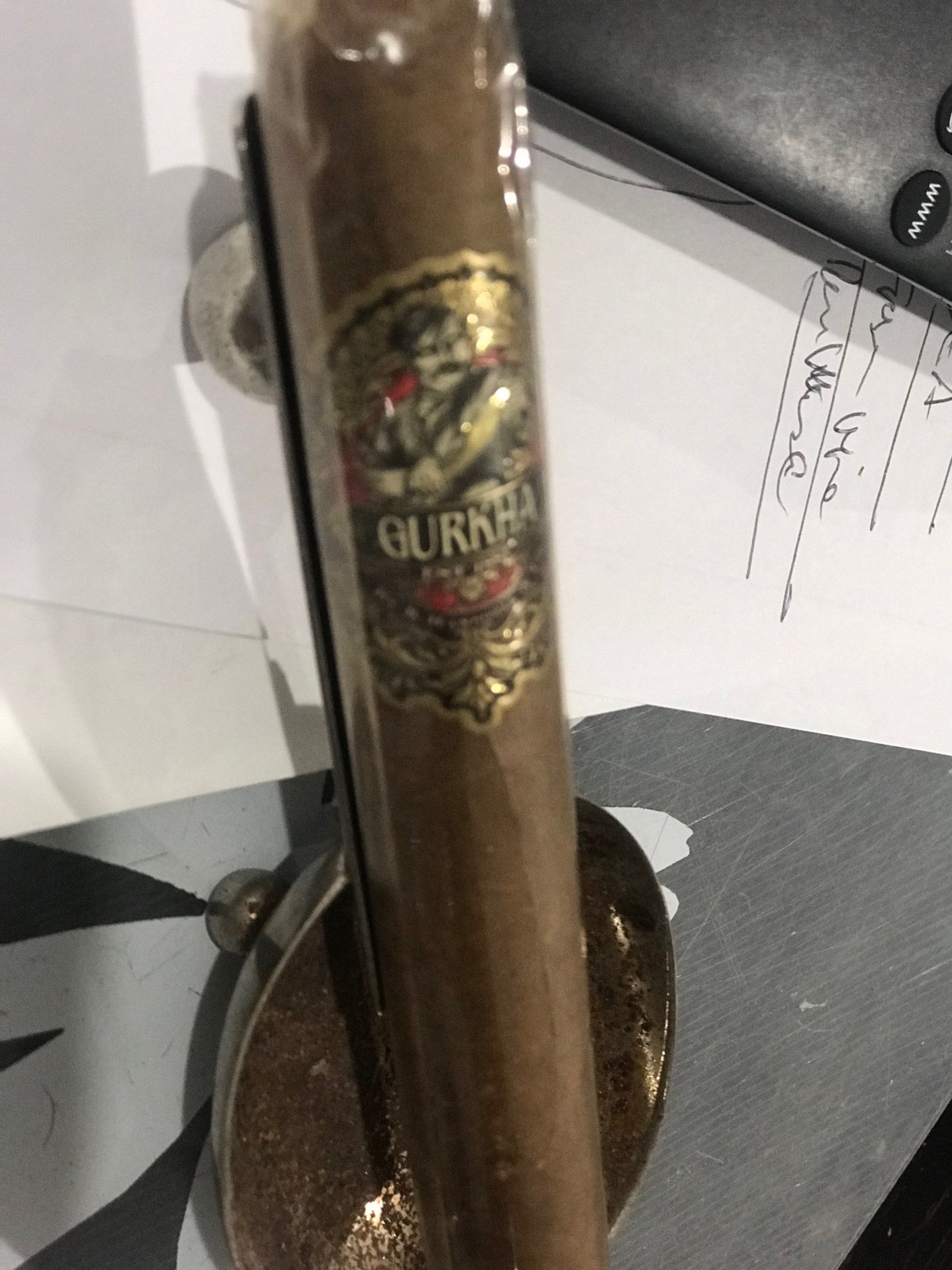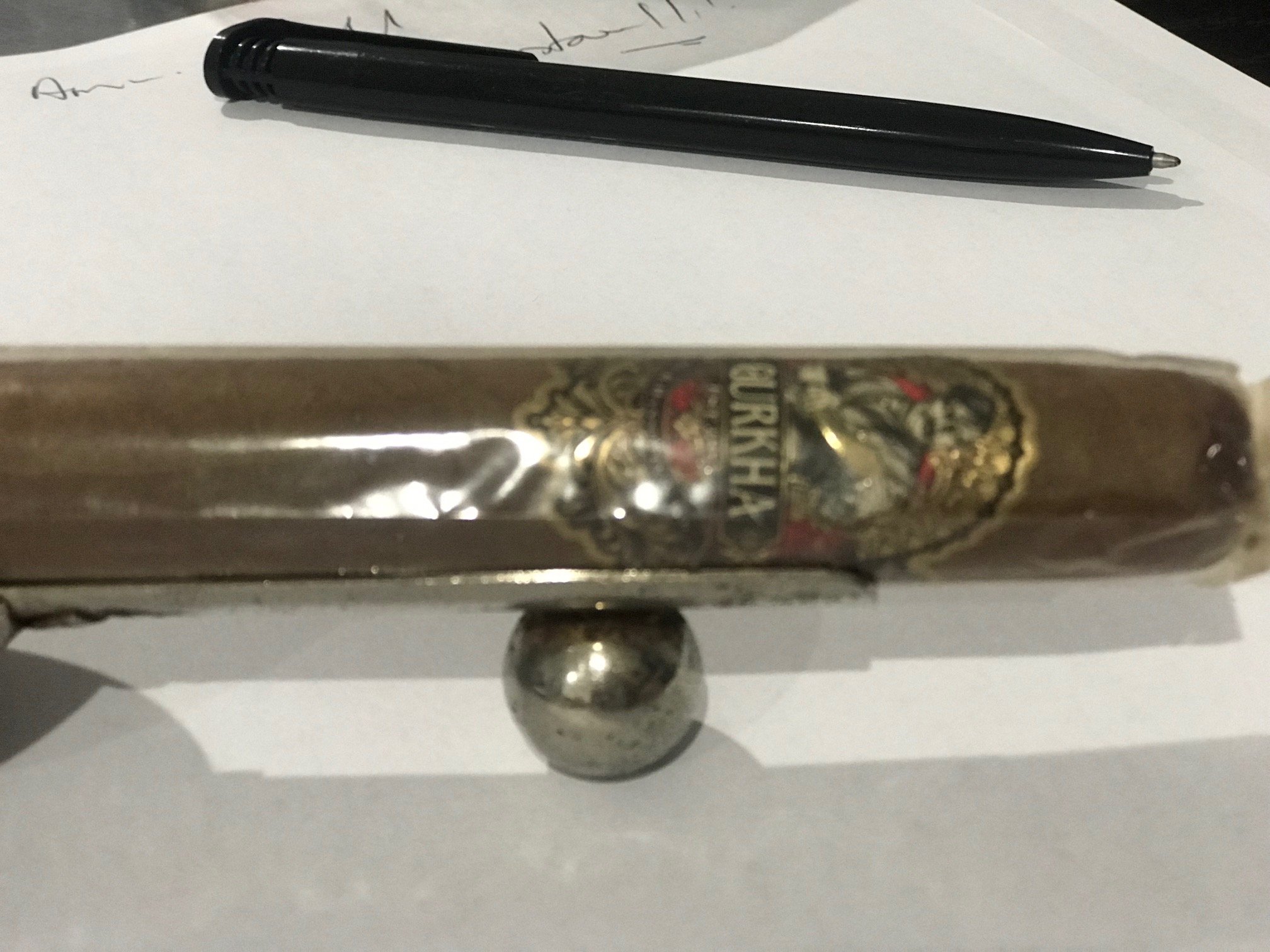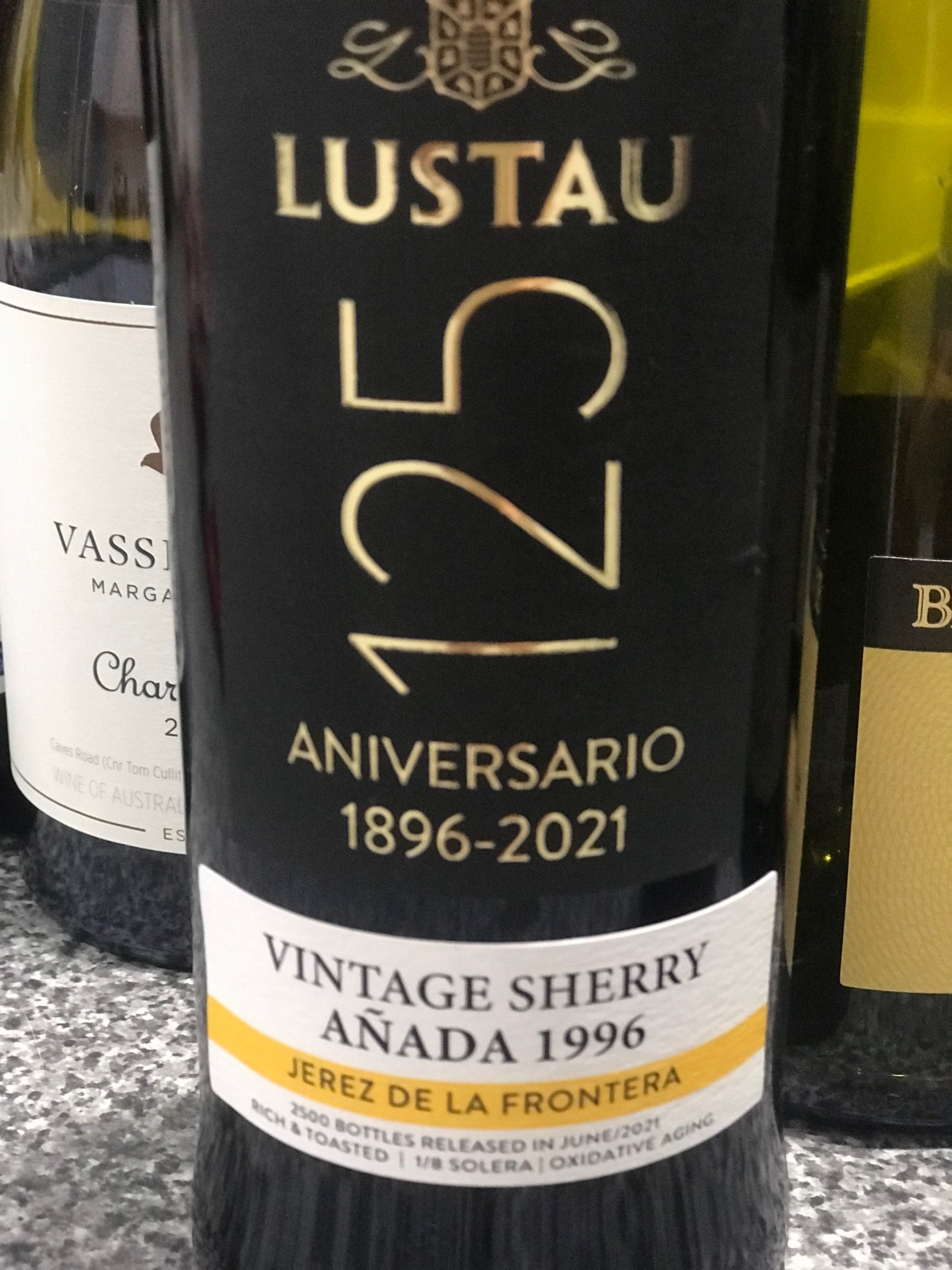Gurkha 125th Anniversary Rothchild – Lustau 125th Anniversary 1996 Añada Vintage Sherry
Well, this certainly did not go to plan. In the bundle of Kenfessions cigars, a Gurkha (actually, two). Never had one. Well, so I thought. The first draft was sent back to me with evidence of a Kenfessions I did ages ago with a Gurkha. So obviously it was not something which made an impression on me.
Mind you, if I were an alien and FoH was my reference point for cigars (which, of course, it is), I would assume that Gurkha cigars were only smoked by the Four Horsemen and that the makers made Bernie Madoff look like Mother Teresa. These are, I have been assured, extremely expensive cigars, for the most part, and yet they are more or less described on FoH as toxic excrement.
As I mentioned, I mistakenly thought that I had never had one. I am 99.9% Cubans only, because that is what I like and what is available to me. It is not because there is simply no FoH love for Gurkhas. To be honest, I’ve always been a little keen to find out if they are as bad as many claim or if it is just a value thing.
This one was marked on the cellophane as the ‘125th Anniversary Rothchild’. I have no idea where that sits in the Gurkha pantheon, but, according to my research on the ever-reliable internet (I have Annie Lennox and the Eurythmics singing, ‘Would I Lie to You’ bouncing around my skull now), it was around US$160 a stick. Proving that either the internet or myself using the internet is not as reliable as we would wish (yes, almost certainly the latter). Seems they are around US$6 to $10 (so in fairness, around A$160 a stick here). So we can’t fault it for price (although rubbish at peanuts is still overpriced – we just needed to work out if these were as bad as I have been led to believe).
Put simply, they are not. This was fine. Okay, perhaps not a 2003 Siglo VI, but I quite enjoyed it. Not sure why the hate? Granted if it was priced at $160 I might be a little harsher in reviewing it.
Quite a loose, easy draw, though the construction is immaculate. The flavours are immediate and consistent pretty much throughout. That would be a small criticism, that there is no evolution here.
Toasty notes from the kick-off. Some chocolate and leather. There was also a flicker of a character that I tried and tried to identify but could not. Whatever it was, it reminded me of something from my childhood. A mystery, but it was certainly not unpleasant. The toast continued, with some dried herbs and spices and a touch of honey towards the finish. There was also a note of a pleasant raisiny character. A gentle sweetness was carried the length. No real complexity here, but it was perfectly pleasant. For me, 89-90 (in fairness, that might be a touch generous in response to this not being the toxic dumpster fire I was led to believe it would be). Nothing too special but certainly far better than expected. Apparently it has a Cuban-seed, Brazilian Habano wrapper with Dominican, Nicaraguan and Brazilian fillers. Six inches with a 54 ring gauge.
Why 125th Anniversary? Apparently the Brits started smoking cigars from local tobacco in Nepal in 1887. Who knew? I believe that these were either released, or first released, in 2012.
Quite like the name. I remember that my old man always spoke glowingly and with immense respect about the Gurkhas – I mean the Nepalese soldiers, not the cigars. Never quite knew why as I doubt he ever met one.
This all preceded shocking news later that night, around midnight. The death of Shane Warne. I cannot remember this nation being in such shock – the passing of Steve Irwin probably the closest thing but this goes much further. I ended up on the phone to friends, all equally in shock, till about 3am. But that was yet to come and I cannot even bring myself to write about him here. Might do a spiel on the next vid. A true legend.
So, what is billed as a 125th Anniversary cigar – with what do you match it? What else but a 125th Anniversary wine and it just so happened that I had a few available. A trio of stunning sherries from Lustau. I have just finished a piece on them for Quill and Pad so allow me to plagiarise from that and tinker with it a little.
Among my (many) failings is a total lack of any sense of direction. I'm hopeless.
Many years ago, on my first visit to Jerez and surrounds, I had an appointment to visit what was to me, the most exciting producer in the region at the time – Lustau. I was staying, as I have every visit since, in nearby Sanlúcar de Barrameda, which is not far from Jerez, the main city and home to Lustau. Sanlúcar de Barrameda is on the Atlantic coast as part of the province of Cadiz, specifically at the mouth of the Guadalquivir River. Anyone visiting the region, I could not recommend this little town more.
Why not stay in Jerez? Sure, it would be more convenient, especially if you are here for the sherry industry? Perhaps, but Sanlúcar is much smaller and easier to get around. A little cooler being on the water – depending on the time of year, that can be important. There is a lovely boardwalk arrangement along the water with plenty of little restaurants and bars (my morning walk would usually see me perched at a bar enjoying a coffee or cerveza, tapping away on the machine or relaxing with a book). And life centres around the local square, Plaza del Cabildo. This is important because this is where you’ll find the wonderful Casa Balbino, surely the best tapas in all Spain. You can see why I love the place.
I am a huge fan of Casa Balbino, but I’ll confess – there have been visits when I have strayed. Thought I'd see what the competition offered and sometimes, it has been excellent. But I always come back. Love this place and I’ll often end up having breakfast, lunch and dinner here, every day during my stay.
On one visit to the region some years ago, I had been at one of the great sherry bodegas for the morning and my host suggested we go for lunch. He knew a place. Was convinced I'd love it. Best in Spain, etc, etc. So off we drove and I’ll admit, with my sense of direction, I was lost. We came into Sanlucar from a different direction to that which I usually did, so I did not even realise that we were there. And we entered the lunch destination from a side alley. It was only when I was inside did I recognise where I was – Casa Balbino. Meanwhile, the regular cadre of waiters started the usual chant, ‘Aussie, Aussie, Aussie’ (apparently I had taught them well). My host was rather stunned and a bit put out to discover that I was better known in his fave restaurant than he was. That is what eating there three times a day will do for you. I digress.
Sanlúcar literally drips history, especially every time a sherry is served. It was recovered from the Moors in 1264 and later became one of the Atlantic’s most important trading ports. Once the New World had been discovered (doesn’t that just put us youngsters in our place), it became the focus for the Spanish conquistadors leaving on voyages of discovery and plunder. It was from here, on 30th May 1498, that Christopher Columbus set off on his third voyage. Ferdinand Magellan also set forth from Sanlúcar, with his five vessels after traveling from Seville, and it was to here that his sole remaining ship, the ‘Nao Victoria’, the first ship to circumnavigate the globe, eventually returned (Magellan himself unfortunately missed the homecoming, having been murdered in the Philippines). Sanlúcar has also produced some of Spain’s most famous bullfighters.
These days, while still an important fishing port, its main claim to fame is as one of the three main towns which form the sherry triangle – along with Jerez de la Frontera (usually just called Jerez) and El Puerto de Santa Maria (usually dubbed Santa Maria). Sanlúcar is home to the amazing Manzanilla sherries. Indeed, without sherry, surely the town in Spain with, allegedly, the highest rate of unemployment would suffer even more extensively.
Back to that first visit. I had a couple of producers lined up but I’ll confess that the one which most excited me was Lustau. I hail from a family which always believed that arriving ten minutes early was ten minutes too late, so I had set off for my appointment, somewhere in downtown Jerez, with plenty of time to spare. It is around 30 minutes’ drive through the vineyards to Jerez from the town of Sanlúcar. Then I looked for the place. I looked and looked. I asked people who gave up nothing but blank stares. I tried all the maps I had. I drove back and forth across the city and even got out and walked around where I thought the place should be. No sign. No hint of a sign. And of course, this was in days before everyone had a mobile phone glued to their hand/ear, guiding their lives. And also before we had the benefit of the internet (well, before I had the benefit of the internet), so forget GPS. I never found the place. Letters of humble apologies were penned. A call back to Australia to the local importers to express my mortification.
I have been back a number of times and never been game to try again, but even travelling around Jerez, I still have never come across the place (reminds me of the building in Harry Potter which disappears before one’s eyes).
Still, I have never let my appalling sense of direction interfere with my admiration for the magnificent sherries they make. Indeed, when sherry was largely in the doldrums – lots of fairly average products, little innovation and a consumer list mostly consisting of grandmothers and maiden aunts – this was the small operator which was the light at the end of the tunnel. These days, they have been joined in the excitement stakes with the wonderful Equipo Navazos team and newcomers like Peter Sisseck’s Vina Corrales.
Lustau, more fully known as ‘Emilio Lustau S.A.’, had its genesis back in 1896. Senor José Ruiz-Berdejo, whose day job was secretary to the Court of Justice, began cultivating the vines on his family’s estate (apparently, the secretary to the Court of Justice had considerable spare time on his hands). He became what is known as an ‘almacenista’. It means a storekeeper, wholesaler or warehouse operation. There were once more than fifty almacenistas operating in the Sherry region but the latest figures, from 2019, showed that number was down to just 17, and they now look after just 7% of the sherry stocks in the region. They are a dying breed.
Basically, these operations are typically family businesses which mature sherries in their own cellars. They will sometimes make the base wines, but usually they purchase it for subsequent ageing. They are not typically selling or exporting. They supply these sherries to the major producers who incorporate them in their own wines. It is a longstanding practice and certainly not one which intends any deception or illegality. This is the way it works there. A producer might approach an almacenista if they run short of their own supplies or if they need a certain style to boost the complexity of the finished wine or simply want to expand their blending options. It was a practice that once occurred in Oporto and Madeira as well.
Basically, the almacenistas are found in the shadows of the industry, but one has dragged them very much into the spotlight – Lustau. A former almacenista itself, Lustau came up with a brilliant concept. At the beginning of the 1980s, Lustau released a series of sherries under their ‘Almacenista’ range. To date, they have released bottlings from more than 20 different almacenistas, as well as copyrighting the name for their wines. This was really the first exciting thing to happen to sherry for many years.
Unfortunately, at that time, almacenistas were struggling, along with much of the entire industry. Up until the middle of the 1990s, a bodega needed to hold stocks of a minimum of 12,500 hectolitres in order to get a licence to bottle sherries, ship and sell them. It was impractical for many to do so, so they operated as almacenistas. Then in 1996, the minimum quantity was reduced to 500 hectolitres, opening up opportunities for those almacenistas. And in turn, opening up opportunities for sherry lovers to enjoy wines that had previously been off-limits. Win-win!
As mentioned earlier, the operation was commenced by José Ruiz-Berdejo in 1896. His daughter, Maria, married Emilio Lustau Ortega, and the two of them greatly expanded operations. In 1931, Maria purchased a small winery near the centre of Jerez from which to operate, but a decade later, they moved to the city’s historic section and in 2000, purchased six 19th century bodegas in the centre of the city and moved back (good luck finding any of them).
It was in 1945 that the family moved from being solely an almacenista and began bottling their own sherries. The name, Lustau, was adopted in 1950, the same year they began exporting. In 1990, they merged with another producer, the Luis Caballero group, which enabled them to further expand the business. Lustau is, I believe, the only producer to operate bodegas in each of the three towns which form the sherry triangle – Jerez de la Frontera, Sanlúcar de Barrameda and El Puerto de Santa María. They also own over 500 hectares of vineyards in the region. Today, they offer a wide range of sherries in different styles and levels, though it is the ‘Almacenista’ range which most sherry lovers immediately think of when the name, Lustau, is mentioned.
To celebrate their 125th anniversary in 2021, Lustau released a set of three special sherries at the end of last year. These only come as a set (£150-250/A$500 approx.), with each bottle 500 mls. There are only 2,500 bottles of each of the trio. Beautifully packaged, they have never been seen before, and they represent not only the history and the very DNA of Lustau, but also the three towns from the triangle, with one wine from each. For sherry lovers, these are an absolute must.
The three sherries are the Manzanilla Pasada Papirusa from Sanlúcar de Barrameda, the Amontillado Solera del Castillo from El Puerto de Santa Maria and the one I paired with the cigar, the 1996 Añada Vintage Sherry from Jerez de La Frontera.
This was originally laid down in 1996 (obviously), the year of Lustau’s centenary, and bottled with 25 years of age for their 125th.
The grapes were left on the vines for a longer period than usual to build some late harvest characters. The wine was then sealed in old butts which had previously been home to Oloroso sherry. Just eight casks were made.
The style is what is known as Dulce, previously called Oloroso Abocado. Often this style was sweetened by the addition of Pedro Ximenez grapes, but here it is the late harvest which allowed the sweetness to build. The fermentation was then arrested mid-way, leaving the level of residual sweetness at an imposing 206 grams/litre. Alcohol is 21%. A lovely old brown colour with flecks of green on the edge. Notes of treacle, apricots, nuts, ginger, glacéd fruit, cocoa powder, caramel and licorice. A seriously intense nose. Even though the wine is technically very sweet, the balance dissipates the suggestion of that to some extent. Gentle yet vibrant acidity is left to counter that sweetness, which works wonderfully well. Amazing length. Another stunning sherry, one which is an absolute must try for lovers of this great wine. And a sherry that would be amazing with any cigar.
KBG








